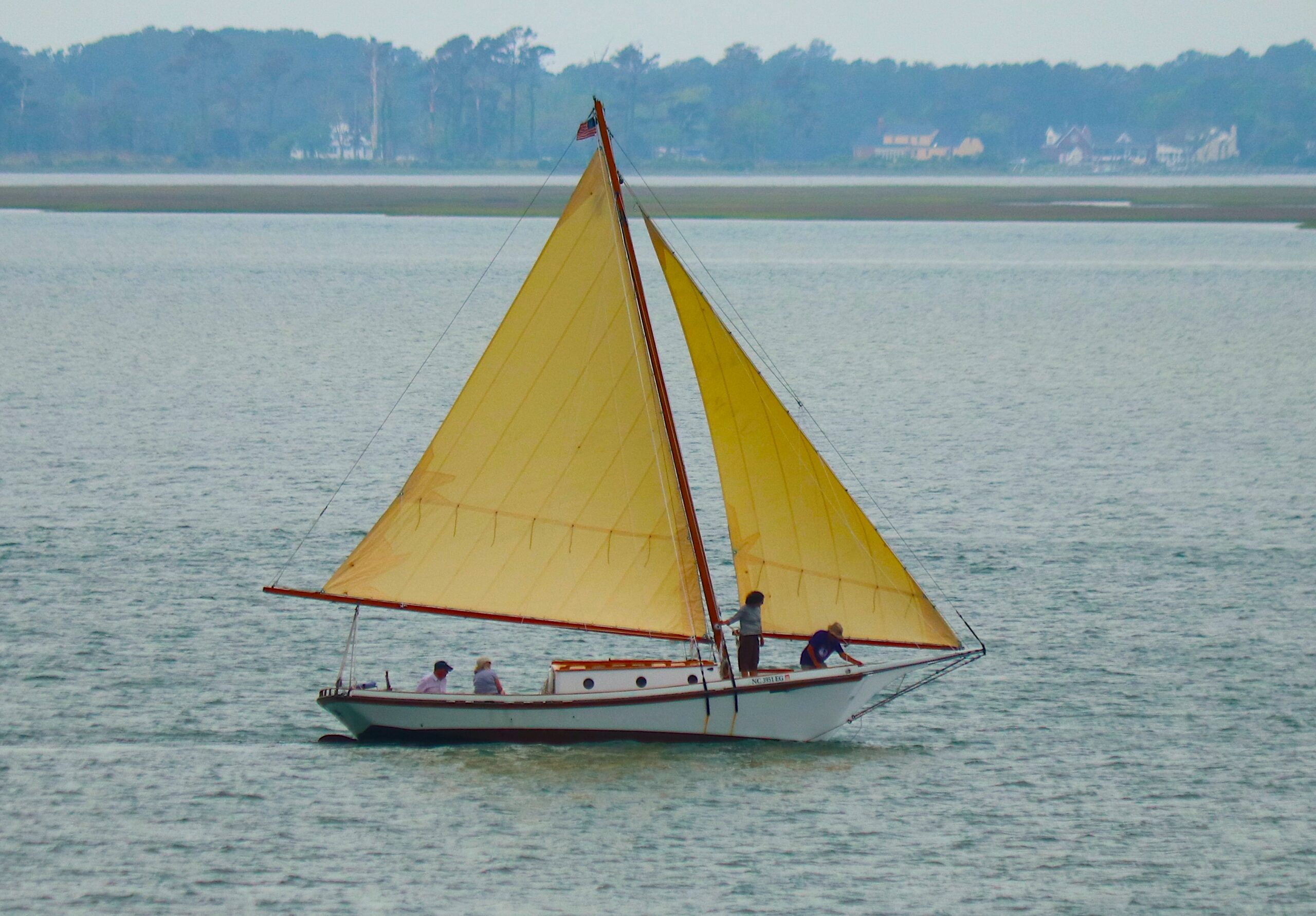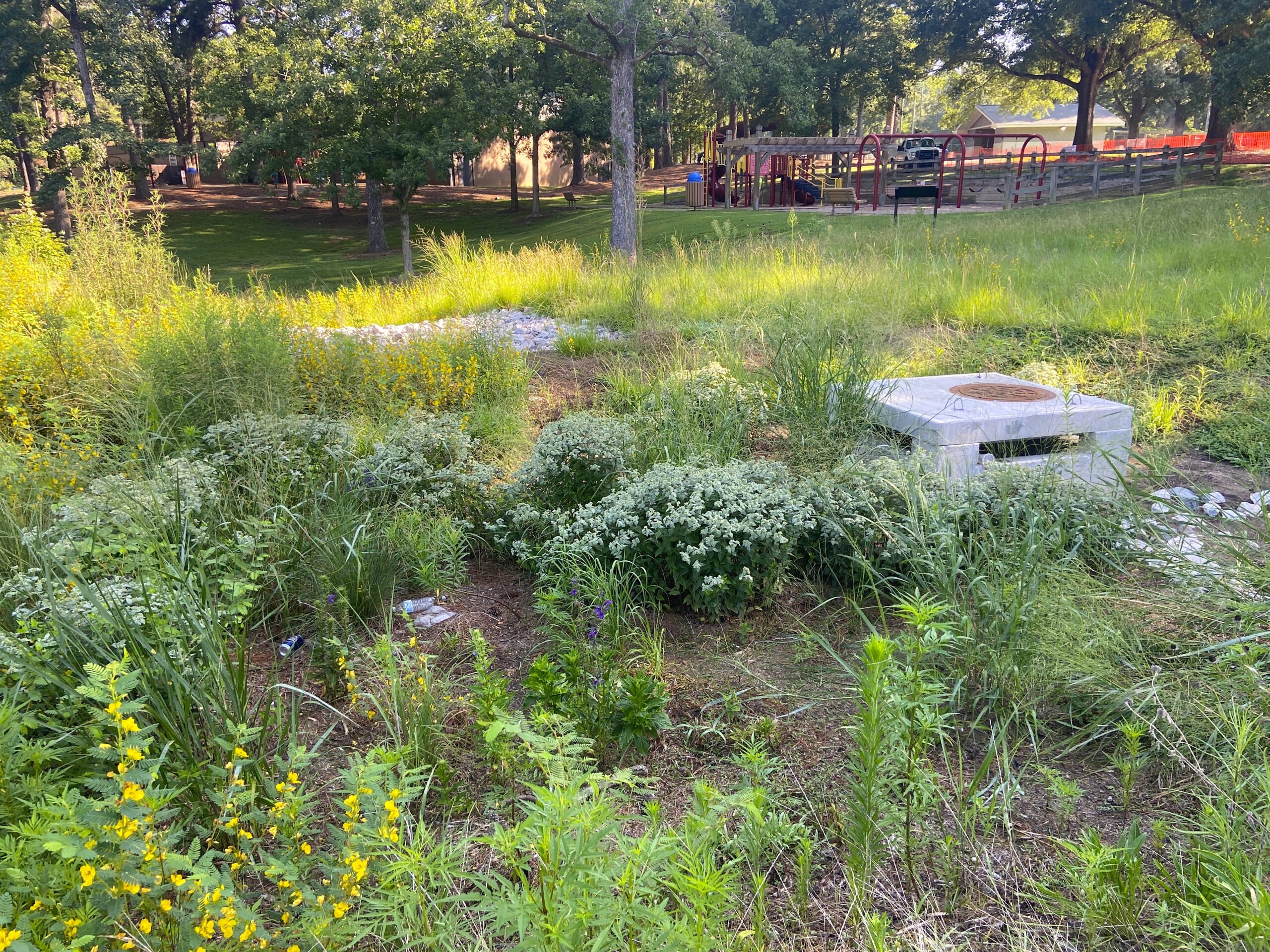While sailing out of Beaufort Inlet with a group of teachers, Capt. Ron White yells, “Prepare to jibe. The sail will go in the opposite direction. The boat will tilt.”
With these instructions, Newport Middle School teacher Ed Lindberg pulls up a winch handle attached to a sail. Then the Good Fortune slowly heads toward a buoy.
“We’re smoking now,” says White, a veteran sailor and marine biologist. “We are going almost nine knots. If we sailed due east, we could be going to Africa. Baghdad is due east about 5,700 miles. Los Angeles is due west.”
For more than an hour, White gives a lesson in sailing dynamics — from terminology to choice spots for sailing around the world.
As the 41-foot sailboat nears Shackleford Banks, White points out a northern gannet diving into the water.
“The gannet makes the pelican look like an amateur,” adds White. “The gannet can hit the water and go 50 feet into it, or hit the water from as far away as 50 feet in the air.”
NAUTICAL SEMINAR
The cruise is part of “The Age of Sail” seminar sponsored by the N.C. Center for the Advancement of Teaching (NCCAT), which provides opportunities for teachers to participate in experiential learning and professional networking.
For elementary teacher Robin Darden of Sanford, who has battled two bouts of cancer, the sailing trip was like a dream come true.
“Being on a boat is a lot different than being on shore,” says Darden. “I find a lot of peace at the ocean. The whole week was a spiritual experience for me and so many other people.”
NCCAT seminars — often referred to as “Outward Bound for teachers” — are open to any North Carolina public school teacher employed for at least three years.
“This seminar is perfect for NCCAT’s vision of giving teachers a deep personal and professional renewal outside of the classroom,” says Donna Glee Williams, the seminar co-leader along with Pat Queen. “Sailing allows them to get out onto the water and learn history, science and music — and build self-esteem skills.”
The seminar also is a beautiful blend of all that the center cares about, adds Williams, who is on the NCCAT program faculty. “It lends itself to an integrated curriculum and connects North Carolina history with world history, literature and physics.”
Twenty-three teachers from across the state participated in the sailing seminar that included all aspects of sailing — from the history of sailing to sea songs and chanteys.
“I live at the coast and know a lot about boating,” says Wendy Milligan, a counselor at Shallotte Middle School in Brunswick County. “The coast is rejuvenating. The ship and captain are like a school. The captain is the leader and keeps the ship from going down.”
The sailing seminar was held at the Trinity Center at Salter Path so teachers could experience the sea life of both the Atlantic Ocean and Bogue Sound.
To help the teachers leam the parts of a ship, the instructors used a model of the USS Constitution, the Navy’s only remaining sailing vessel in commission. Borrowed from the Macon County library in the N.C. mountains, the model — which is 38 inches long and 29 inches tall — is an invaluable learning tool.
“Having a ship model in the room helped bring the seminar alive,” says presenter John Slater, who is retired from the U.S. Naval Reserve and an avid sailor. ‘The teachers got a feel for the complexity of a sailing ship’s masts and rigging.”
To get a glimpse into North Carolina’s sailing heritage, the group toured the N.C. Maritime Museum in Beaufort. The museum has a variety of sailing exhibits and relics, including a spritsail rig used by commercial anglers and navigational instruments.
“I am not a native of North Carolina and had no idea how much shipping and fishing heritage was in North Carolina,” says Julia Hooks of Weddington High School in Union County.
NCCAT INCEPTION
The idea for NCCAT was bom in 1983 when Jean Powell spoke to the N.C. Commission of Education for Economic Growth.
As the N.C. Teacher of the Year in 1983, Powell thought that providing a time and place for teachers to become students again would give them a renewed perspective of the student’s role.
Then-Gov. Jim Hunt and the N.C. General Assembly shared Powell’s vision and setup NCCAT in 1985. One year later, full-time operations began on the campus of Westem Carolina University in Cullowhee.
Residential seminars are the heart of the NCCAT experience. Each year, the center sponsors more than 70 seminars. This year, the themes ranged from the history and culture of the Cherokees, to the struggle of black women in America.
Besides seminars, the NCCAT Teacher Scholar Program provides opportunities for professional research and independent study, including preparation for national teacher certification.
Since its inception, more than 70,000 teachers have participated in NCCAT seminars. During the 2004 school year, more than 5,000 teachers spent up to five days at various NCCAT programs.
“Whether you have taught five years or 25 years, you need to get away from the classroom,” says Hooks. “When you step away from what you are doing, you come back more inspired.”
When Hooks got back to her classroom, her students told her she seemed happy and energetic — like during the first week of school.
“The seminar reminded me of how much I loved to learn,” she says. “It helped me to be more creative in my lesson plans and put me in the kids’ shoes.”
For many participants, the seminars are so invigorating that they return again as alumni.
“I have been teaching 36 years,” says Lindberg. “This was my second NCCAT seminar. It was an interesting and relaxing week. You got to meet a lot of cool people. You also got pampered.”
IMPROVING TEACHER RETENTION
Across the country, teacher retention is a major problem for public schools.
During the 2003-2004 school year, North Carolina’s local school systems reported an average teacher turnover rate of more than 12 percent, according to the N.C. Department of Public Instruction. Of the 11,399 teachers reported leaving, 31.5 percent had tenure.
“When a teacher quits, it is a huge expense forthe state,” says Williams. “One of NCCATs visions is to make it possible for teachers to stay in teaching and save the state money.”
Over the years, the center has become a national model. In 1995, U.S. leaders of education, business and government gathered in Cullowhee for a meeting of the National Commission on Teaching and America’s future. In recent years, delegations of educators, community leaders and politicians from across the United States have traveled to the center to study its model.
Georgia has a center north of Atlanta that is modeled after NCCAT. There, teachers leam to become advocates for reform in their schools. There also are similar programs in San Francisco, Minnesota and Florida.
‘Teachers tend to get boxed in and bogged down with day-to-day details of teaching,” says Terri Kirby Hathaway, North Carolina Sea Grant marine education specialist, who has participated in NCCAT workshops. “NCCAT offers these teachers a way to break out of that box and refresh their learning skills.”
COASTAL ENVIRONMENT
As teachers gather at the Trinity Center’s Beach House overlooking the Atlantic, Slater takes them back to an era when seamen set their own time by bells and hourglasses.
“They were out there i n the wet weather and spray,” says Slater. “Nobody carried a watch. But they did use a bell to announce the passage of time.”
He says that each watch lasted four hours. At the end of each half hour, a sailor would ring the bell.
“Each time the sailor struck the bell, he would turn the hourglass,” says Slater.
To set the starboard or early morning watch, Bumsville elementary teacher Brenda Phetteplace goes up to the bell and strikes it twice. She then turns over the hourglass.
‘The ship was a universe unto itself,” says Slater. ‘You had to carry out duties and be honest and fair. The only real opportunity for the sailors to jump ship was at port.”
While the hourglass is filling up, Slater goes over ship vocabulary and sailing history.
“Until the 1930s, there was commercial sailing,” says Slater. “Sailing now is essentially recreational.”
When the hourglass becomes half full at 9:30 a.m., Phetteplace rings the bell three times.
“I read sea novels,” she says. “I just love sailing. I have a small sailboat, but don’t get to use it much because I live in the mountains. Here I can experience beautiful sailboats at the marinas.”
Later in the day, the teachers divide into two groups. One group goes to the beach and builds a sand model of the Cutty Sark, an English ship built in Scotland in 1870.
“We brought the plans for the tea clipper,” says Slater.
The others stay inside and leam to make a monkey knot used as a weight for a heaving line on a boat.
Using a piece of rope and some marbles, Williams shows the teachers how to tie a massive knot around a marble.
‘This is fun,” says Mike Turner, a physical education teacher in Davidson County. “I have never made a monkey knot before.”
When Darden returned to her kindergarten class, she taught her preschoolers how to tie knots.
“My students were mesmerized by the experience,” she says. “They got to make a monkey knot.”
Darden also brought back seashells for each student. “A lot of my students haven’t ever seen the ocean. They were so excited to get the seashells and hear the ocean. We also did a measurement in the hall to show how big a ship is and made drawings of a sailboat.”
NEW OCRACOKE CENTER
With the opening of the old U.S. Coast Guard station in Ocracoke in 2006, NCCAT will be offering more coastal courses. The renovated education center will have sleeping quarters for teachers, as well as seminar rooms.
The station, a prominent white structure on the mouth of Silver Lake harbor, has been vacant for several years. The federal government transferred the building to the state of North Carolina in 2001. Since then, the state has been renovating the facility.
At the Ocracoke center, teachers will follow a schedule similar to those that NCCAT provides on its main campus in the mountains. The center will offer a range of subjects, including topics related to the coastal environment.
“However, we won’t just focus on coastal ecology,” says Williams.
During construction, the crews discovered relics of the past — from an old newspaper tucked behind a wall to charred timbers burnt in a fire.
Some interesting island history has been uncovered that will enliven teacher discussions, says NCCAT executive director Mary McDuffie.
As construction moves forward, NCCAT staff members also are gathering stories from former Coast Guard personnel who served on Ocracoke.
“We are trying to locate these personnel and compile an oral history,” says Alton Ballance, project facilitator on the Ocracoke campus. “We recognize that interviews and actual documentation from the crews and their stories are an important part of the history of the station.”
McDuffie says the eastern campus will become a special place for North Carolina teachers.
“It will make NCCAT programs more accessible for those who live and work in the eastern part of the state, and will be instrumental in helping NCCAT to retain the quality teachers so essential to the success of North Carolina’s school children,” adds McDuffie.
Teachers, media specialists and school counselors can apply for NCCAT seminars. Call 800/922-0482, send e-mail to information@nccat.org or visit the Web: www.nccat.org. To learn about the Ocracoke project, contact Alton Ballance, ballancea@nccat.org.
This article was published in the Autumn 2005 issue of Coastwatch.
For contact information and reprint requests, visit ncseagrant.ncsu.edu/coastwatch/contact/.



